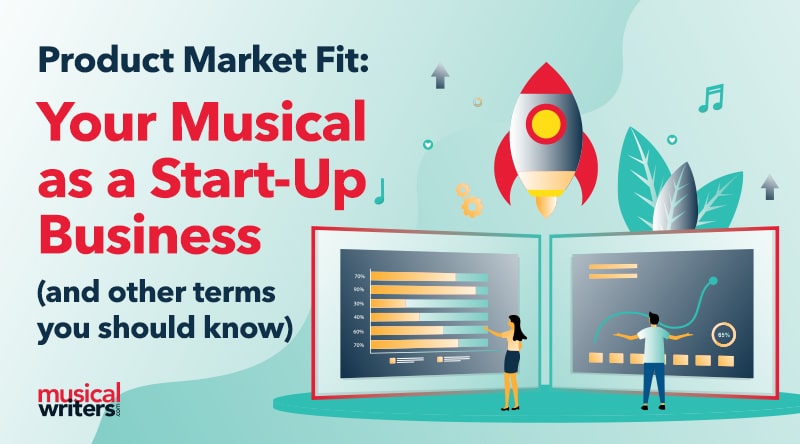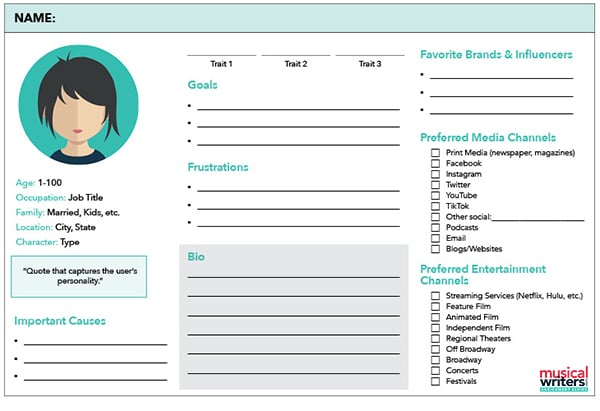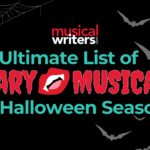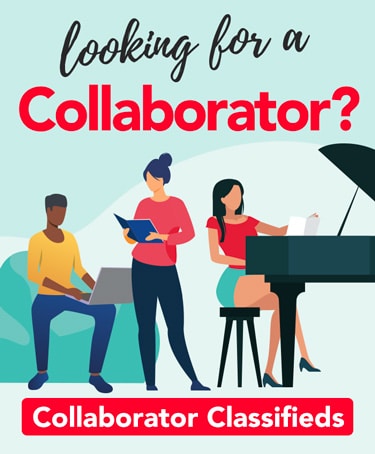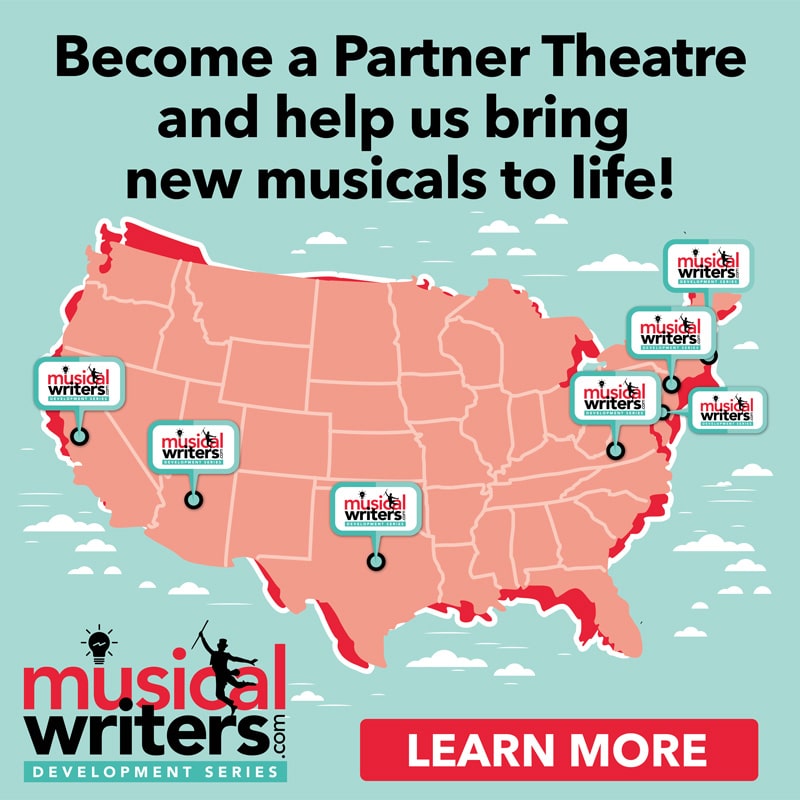I recently was a participant in the Spring 2020 Cohort of the Apples and Oranges Arts THEatre ACCELERATOR, a 2-week intensive that considers each project a startup and each artistic creator an entrepreneur.
“We aim to create a healthy eco-system where projects/startups and artistic creators/entrepreneurs will thrive. The Silicon Valley of musical theatre.”
~Tim Kashani, founder of the Apples and Oranges Arts THEatre ACCELERATOR
Using his expertise in the business and tech startup world, Tim encouraged us to explore the concepts of Persona Mapping, Product Market Fit, Total Addressable Market, and Minimum Viable Product as it relates to our show, its audience, and its ideal trajectory. As the owner of two companies (and an avid fan of Shark Tank), I had a basic awareness of how these concepts work in the business world. I was also privy to the idea of a musical as a product. However, I enjoyed learning about how all of these concepts melded together to help us determine the best path in both development and marketing.
Persona Mapping
Persona Mapping, also known as user personas and empathy mapping, is the creation of fictional but realistic profiles of your target customers. They reflect characteristics like personal attributes, goals, motivations, attitudes, fears, obstacles and more. Empathy mapping helps us consider how other people are thinking and feeling. It reveals the underlying “why” behind users’ actions, choices and decisions. 1
Sound familiar? It’s much like the character development you do when creating your show.
Persona mapping tools are useful both in exploring your characters and exploring your audience. It’s important early on to ask “Who is your show for?” and “Who will be buying the tickets?”
Above is a sample Buyer Persona I created on Extensio. For a printable PDF worksheet, download our Buyer/Audience Persona Worksheet below.
Knowing the nuances of your target audience can help when pitching your show to producers and theaters. Be sure your show and the theater you’re pitching to have the same audience in mind.
Product Market Fit
According to Wikipedia, Product-Market Fit is the “degree to which a product satisfies market demand, and is the first step to building a successful venture in which the company meets early adopters, gathers feedback and gauges interest in its product(s).”2
Tim Kashani translates it to the theatre industry this way:
Product Market Fit means:
- We have a product (a musical).
- What is the size of the consumer market (audience) that this product (musical) fits?
- Most importantly—who are the people who make up this consumer market?3

This is an important concept both for someone starting a new business and for someone developing a new musical. The following quote can apply to both:
“Most startups fail because they burn through cash without first carefully considering or planning for the moment when customers actually want what they are selling. Achieving product-market fit is one of the most important goals for a startup, yet it is also one of the least understood concepts.”
~Hailey Leibson, contributor for ForbesWomen in this Forbes article.
Consider: Is there a market for your show? Are people craving content similar to the style, genre, theme, story and issues your musical represents? If your show is about an alien in search of fruity shampoo to ensure his survival (?!), is there a market out there who will be excited to buy the ticket and the t-shirt? If so, great! Even if it’s small, that’s okay. Just know. Know what your show is and who it’s for. Be sure there are actual people out who love things like that, and know who and where they are.
This list by CBInsights shows the Top 20 Reasons Startups Fail. How many of these can be applied directly to creating new musicals? (I would say most if not all.)
- No market need (42%)
- Ran out of cash (29%)
- Not the right team (23%)
- Got outcompeted (19%)
- Pricing/cost issues (18%)
- User un-friendly product (17%)
- Product without a business model (17%)
- Poor marketing (14%)
- Ignore customers (14%)
- Product mistimed (13%)
- Lose focus (13%)
- Disharmony among team/investors (13%)
- Pivot gone bad (10%)
- Lack passion (9%)
- Failed geographical expansion (9%)
- No financing/investor interest (8%)
- Legal challenges (8%)
- Didn’t use network (8%)
- Burnout (8%)
- Failure to pivot (7%)
Notice #1 directly addresses Product Market Fit. If you want your show to reach a broad audience, it has to appeal to a broad audience.
Are you struggling with any of these? How can you address these concerns? Feel free to leave a comment!
Further study: 12 Things About Product Market Fit
TAM SAM SOM
No, this isn’t a new dumpling dish to be tried on the Amazing Race. While these terms may sound foreign to our ears, they’re extremely well known in the business world. Total Addressable Market (TAM), Serviceable Addressable Market (SAM) and Serviceable Obtainable Market (SOM) are a mouthful, but the concepts are simple.

Total Addressable Market
In the diagram above, the largest, outer circle is the Total Addressable Market. In the theatre industry, the Total Addressable Market can refer to the overall demand for theatre. In other words, every single person who could ever see your show.
Serviceable Available Market
Secondly, the Serviceable Available Market are the theatergoers you can reach. These are fans of your genre and supporters of the themes present in your show. They may be physically out of reach at the moment, but they’re watching for where your show goes next.
Serviceable Obtainable Market (Target Market)
The smallest concentric circle is your Serviceable Obtainable Market. This is your current goal—your target market. It represents how much of the market you can realistically reach. Remember Product Market Fit? These are the people who are ready to get in line or click purchase for a ticket sale.
While it’s not necessary to do a lot of super analytical number-crunching, when you’re pitching, it is good to be aware of the segments you’re trying to reach. You want the SOM circle to be sizable enough to entice investors and producers to get on board. Use your Persona Mapping tools to define exactly who lives in this circle.
Minimum Viable Product (MVP)
When creating a new product or service, companies use the concept of the Minimum Viable Product—a streamlined, basic version of a product or service created to get feedback. In a momentum-gaining cycle, that feedback is then integrated back into the product, creating a MVP “version 2.”

Eric Ries popularized the concept of the MVP being the “smallest possible experiment” to test a specific hypothesis, the end goal being to specify your particular Product Market Fit.
For theater purposes, let’s consider the MVP the simplest iteration of your show that can test your market response.
In the article “The Lean Model for Musical Theatre,” Tim Kashani states,
“Just like startups, you begin with your story. That’s your hypothesis. Your drafts are your MVP or your MVM (Minimum Viable Musical) that you can share with colleagues, audiences, mentors. Also like startups, you move quickly from draft to draft, improving and refining.”
The evolution of the MVP
For your musical, the evolution of your MVP might look like this:
- 1st MVP: First Draft + Basic Demos
- Test scenario: Table Reading
- Test Audience: Friends
- Cost: Minimal; <$100
- Feedback: Is anyone intrigued? What in particular is capturing their attention? What is confusing? Is the story interesting? Does this show feel right for this moment in time?
- Next Step: Rewrites
- 2nd MVP: Second Draft + Updated Basic Demos
- Test Scenario: Professional Script Review
- Test Audience: Professional Dramaturg or Director
- Cost: <$500
- Feedback: Issues with story structure, character development, song spotting, tone, etc.
- Next Step: Rewrites
- 3rd MVP: Concert Reading
- Test Scenario: Local Concert Reading
- Test Audience: Local Audience
- Cost: <$3000
- Feedback: Implement an audience feedback survey. How does the audience feel about the music? How do the actors and musicians feel about the music (both the characterizations and the music/vocal arrangements)?
- Next Step: Polish score
- 4th MVP: Staged Reading
- Test Scenario: Staged Reading
- Test Audience: General Theatergoers
- Cost: <$5000
- Feedback: Does the audience understand the story? When is the audience getting restless?
- Provide audience feedback questionnaires
- Hold follow-up meetings with individual audience members for in-depth feedback
- Next Step: Consider the best next step.
- 5th MVP: (Your next step)
Our feedback loop is Test, then Rewrite, then test on a larger scale, then rewrite, and repeat. Start small with early feedback, but don’t settle for asking the same 5 friends to review rewrite after rewrite. You’ve got to expand your audience. Yes, there’s more risk, and yes, it’s nerve-racking to open up your work to more and broader opinions, but that’s how it continues to improve and grow.
Forbes author Hailey Liebson goes on to explain,
“….After conducting user tests, analyze and interpret the feedback received. Identify patterns of similar feedback and prioritize any customer concerns so you can address them. Then refine the initial prototype to incorporate their concerns and experiences. Implementing this…process at the outset of product development will lead to more efficient use of resources and a high degree of confidence that when you launch your product, customers will find it valuable.”4
Recommended Reading: The Lean Startup: How Today’s Entrepreneurs Use Continuous Innovation to Create Radically Successful Businesses
Finding Creative and Strategic Balance
While we never want to lose sight of the artistic side of creating musicals, employing some left-brain strategies can help as you seek to propel your show forward. Your musical is your product, your collaborators are your team, and your audience are your customers. Use these tools to better understand how best to appeal to them and where your musical is “positioned” in the market. Then use your creativity to better define your theme, create more relatable characters, and build a story that communicates more powerfully to your target audience.
Many thanks to Tim and Pamela Kashani and the team at Apples and Oranges Arts for the generous sharing of their insight and expertise to musical writers through the THEatre ACCELERATOR. To learn more about how A&O strives to merge business and tech principles and strategies with the arts, or to apply for the next TA cohort, visit https://nycoc.org/ta/. Tim also has written some great articles here addressing these concepts in more detail. To see these concepts used in actual pitches, watch our Spring 2020 cohort’s SingTank session on YouTube.

